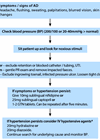Introduction
Metastatic spinal cord compression (MSCC) is an oncological emergency that, unless diagnosed early and treated appropriately, can lead to significant morbidity and mortality, including paralysis and bladder and bowel dysfunction. MSCC can be defined as spinal cord or cauda equina compression by direct pressure and / or vertebral collapse or instability by metastatic spread or direct extension of malignancy that threatens or causes neurological disability.
The true incidence of MSCC in England and Wales is not known, as these cases are not systematically recorded. However, evidence from a published Canadian study [1] and a Scottish audit between 1997 and 1999 suggests that there may be as many as 80 cases per million patients every year. This equates to 4000 cases per year in England and Wales or approximately 100 cases per cancer network per year [2].
Why is MSCC missed?
Low back pain is a very common complaint in primary care with 49% of the adult British population reporting low back pain for at least 24 hours at some time in the year according to a survey published in 2000 [3]. This results in about five million patients a year consulting their GP about back pain. The challenge that primary care faces in this situation is thus trying to identify those cases where the low back pain is due to serious spinal disease such as malignancy. It should be remembered that back pain may be the first presentation of malignancy. About 23% of patients with spinal metastases have no previous diagnosis of cancer [4].
Why is early diagnosis vital?
The patient’s neurological status at the time of diagnosis, especially motor function has been shown to correlate with the prognosis from MSCC. Therefore diagnosis prior to the development of neurology is vital. Treatment before paralysis develops has been shown to be both clinically effective and cost-effective. Although the rate of clinical progression is variable it has been shown that patients with motor dysfunction inevitably progress to complete paralysis without intervention. Approximately half of patients presenting with MSCC cannot walk by the time of diagnosis.
A prospective audit of the diagnosis, management and outcome of MSCC [5] clearly showed that there were significant delays from the time when patients first developed symptoms until the diagnosis of cord compression. The median times from the onset of back pain and nerve root pain to referral were three months and nine weeks respectively. As a result, 48% of patients were unable to walk at the time of diagnosis and of these the majority (67%) had recovered no function at one month.
MSCC in urological practice
Prostate cancer is the second most common cancer in men in the UK and its morbidity and mortality is often associated with consequences of bony metastases. It is second only to lung cancer as a cause of MSCC in men.
Occult metastases are noted in up to 50% of patients with renal cell carcinoma (RCC). MSCC is seen in 5-14% of patients with metastatic RCC, carrying a worse prognosis of less than two years.
Whilst up to 35% of patients with bladder cancer have evidence of bony metastases, with spine being the commonest site, the incidence of MSCC is extremely rare.
Pathophysiology of spinal cord compression
MSCC usually follows haematogenous spread of malignant cells to the vertebral bodies, with subsequent expansion into the epidural space. Spread into the epidural space may occur by means of direct tumour extension through the vertebral canal or haematogenous spread via the Batson’s valveless venous plexus.
The most frequent spinal metastatic seeding occurs in the thoracic spine (about 70% of cases) followed by lumbosacral spine (20%) and then cervical spine (10%). However, multiple levels are involved in 30% of cases [6].
Systemic cancers with a tendency for spinal cord metastasis include breast, lung, prostate, renal and haematological malignancies such as lymphoma and multiple myeloma. Gastrointestinal and pelvic malignancies favour the lumbosacral cord whereas breast and lung malignancies tend to involve the thoracic spine.
Clinical presentation of MSCC
A comprehensive initial assessment is essential for anyone presenting with signs and symptoms suggestive of MSCC which includes their physical (including full neurological examination and digital rectal examination) and psychosocial needs.
Pain:
- It is the cardinal symptom of patients with MSCC although it has usually been present for a median of six to eight weeks before diagnosis. The average time interval between onset of pain and onset of other symptoms is two to four months.
- The pain is often unremitting, not controlled even with significant pain relief such as opioids and worse in a recumbent position and typically worse at night – in contrast to that of degenerative disease.
- The classical thoracic lesion pain is a tight band around chest / abdomen, which is described as ‘squeezing’.
Motor deficits:
- Compression of lower cervical / upper thoracic nerve roots can present with upper limb weakness.
- Leg weakness can occur regardless of level of compression. Almost half of patients have some degree of paresis and 15% are paraplegic at diagnosis.
- Ataxia, loss of co-ordination and paralysis are late findings.
- Initially, deep tendon reflexes and Babinski’s sign are absent but with progression of MSCC, there is hyperreflexia and Babinski’s sign becomes positive.
Sensory deficits:
- Paraesthesias and sensory loss may progressively develop in an ascending manner but poorly localise to the site of lesion.
- There may be altered or loss of sensation to touch, pain and temperature depending on the level and duration.
Autonomic dysfunction:
- Bladder dysfunction is the most common autonomic finding, initially presenting with urinary retention, later progressing to incontinence.
- Decreased anal sphincter tone and bulbocavernosus reflex are late signs.
Investigations for MSCC
Urgent magnetic resonance imaging (MRI) of the whole spine is the imaging of choice in patients with suspected MSCC, unless there are any specific contraindications. Sagittal T1, short T1 inversion recovery (STIR) and sagittal T2 sequences are optimal.
If MRI is not available at the presenting hospital, then patients should be transferred to a unit with 24-hour capability.
If MRI is contraindicated, then computed tomography (CT) scans can be performed. There is limited role for myelography in MSCC and is to be done only at dedicated neuroscience / spinal surgery centres.
Management of MSCC
The National Institute for Health & Care Excellence (NICE) suggests that definitive treatment for MSCC should be started as soon as possible to prevent further neurological deterioration and within 24 hours of diagnosis of MSCC. The aims of treatment of MSCC are a) preservation / improvement of neurological function (especially walking), b) pain relief and c) improvement in quality of life. When planning definitive treatment for these patients, one should consider the patient’s performance status, histology of the primary tumour, and the extent of spinal and visceral metastatic disease.
In patients where MSCC is clinically suspected urgent referral should be made to the local acute oncology team or MSCC co-ordinator who can ensure that all imaging is complete and all relevant clinical information is available. Locally the patient is then discussed with an oncologist. Based on the opinion of the clinical oncologist within the cancer network, patients who may potentially benefit from surgery should be referred for a specialist spinal surgical opinion. A case discussion should take place whenever required, urgently as individual new cases present. These discussions should involve oncologists, spinal surgeons and if required a radiologist.
A. Preservation / improvement of neurological function
Corticosteroids
Steroids are given to patients with MSCC as they are believed to reduce tumour bulk or spinal cord swelling, relieve spinal cord pressure and improve treatment outcomes. Their use may result in a significant improvement in neurological symptoms; there is however, no long-term evidence of survival benefit. The NICE guidelines recommend that all patients with MSCC should be offered a loading dose of at least 16mg of dexamethasone after assessment, followed by a short course of 16mg dexamethasone daily whilst treatment is being planned. A contraindication to the use of dexamethasone is a significant clinical suspicion of lymphoma as the use of steroids here may impair the histological diagnosis. Dexamethasone should be continued in patients awaiting surgery or radiotherapy for MSCC, after treatment has been commenced the dose should gradually be reduced over five to seven days and then stopped. Patients started on steroids should have their blood sugars monitored regularly; we would also advocate the use of prophylactic proton pump inhibitors or antacids to mitigate the potential side-effects of steroids and the risk of gastric ulceration.
Surgery
NICE recommends surgery (decompression and / or stabilisation) in those patients fit for surgery and with a life expectancy of at least three months, and have: a) MSCC and have not had paraplegia for >24 hours, or b) an unstable spine, or c) deteriorating neurological function, or d) pain despite previous radiotherapy.
Radiotherapy
The majority of patients are not suitable for surgery and should receive external beam radiotherapy. There should be access to radiotherapy for these patients within 24 hours, seven days a week unless: a) they are tetraplegic / paraplegic for >24 hours and their pain is well controlled, or b) their prognosis is too poor, or c) surgical intervention is planned.
However, systematic reviews have failed to establish the optimal radiation dose and fractionation [7]. However, it has been recommended to keep the total dose below 100Gy.
B. Pain relief
Patients with MSCC will usually have some accompanying pain whatever their functional status at presentation. The pain can broadly be classified into non-mechanical and mechanical:
- Non-mechanical – i.e. not affected by posture or movement – may be due to dural or neural compression, or due to tumour expansion within the vertebral body. This is usually treated conservatively i.e. with analgesia, radiotherapy and drugs including bisphosphonates.
- Mechanical pain-aggravated by movement, lifting weights or even standing. This is thought to be due to weakening of the bone, treatment is by supporting the spine. This can be done with external devices such as corsets or braces for the trunk and collars for the neck. Alternatively the spine can be supported internally either ‘outside the bone’ with spinal fixation or ‘inside the bone’ with vertebroplasty.
Analgesia
Conventional analgesia has a significant role in the management of cancer patients with pain. Medications (including non-steroidal anti-inflammatory drugs (NSAIDs), non-opiate and opiate medication) should be offered as required to patients with painful spinal metastases / MSCC in escalating doses as described by the World Health Organization (WHO) three-step pain relief ladder.
Bisphosphonates
Bisphosphonates are a group of drugs which affect bone metabolism by inhibiting osteoclastic activity. They are widely used in cancer patients to treat hypercalcaemia and to reduce skeletal-related events (SREs). Patients with vertebral metastases from prostate cancer should be offered bisphosphonates to reduce pain only if conventional analgesia fails to control their pain. Common side-effects of bisphosphonates include nausea, vomiting, anaemia and renal toxicity, which may limit treatment. However, they may not prevent skeletal metastases or prevent MSCC.
Immobilisation
Initial immobilisation plays an important role in patients with severe mechanical pain suggestive of spinal instability / MSCC both for providing pain relief and preventing further neurological deterioration.
Patients should be nursed lying flat with the spine in neutral alignment using ‘log-rolling’ techniques or turning beds until definitive treatment.
Surgery
Complex surgery is increasingly being considered as a treatment modality for otherwise uncontrollable pain in specialist units.
C. Improvement in quality of life
Venous thromboembolism
- Thigh-length graduated compression stockings +/- intermittent pneumatic compression should be used.
- Low molecular weight heparin should be administered to those who are at high-risk of VTE and are suitable for anticoagulation.
Pressure ulcers
- Initial risk assessment should be done at presentation e.g. Waterlow scores etc. and should be repeated every time the patient is turned on bed rest and then daily.
- Patients should be ‘log-rolled’ every two to three hours when on bed rest.
- Regular mobilisation should be encouraged when not on bed rest.
- Patients should be actively encouraged and assisted with pressure relieving activities when not able to mobilise.
- Pressure-relieving devices can be used where appropriate.
- Pressure sore assessments, prevention and healing protocols should be followed as per NICE guidance.
Bladder and bowel incontinence
- Functional assessment at initial presentation is mandatory – then minimum once daily assessment of function change.
- Urinary catheter – consider CISC / suprapubic catheter if long term.
- A neurological bowel management programme should be instituted.
Circulatory and respiratory function
- Patient’s pulse rate, blood pressure (BP), respiratory rate and pulse oximetry should be assessed and monitored.
- Patient positioning and devices to improve venous return can be utilised to manage postural hypotension.
- Avoid over-hydration as it can cause pulmonary oedema.
- Physiotherapists help with breathing exercises, assisted coughing and suctioning to clear lung secretions.
- Biphasic positive airway pressure (BiPAP) and intermittent positive pressure ventilation (IPPV) may be used where necessary.
Rehabilitation and social support on discharge
Discharge planning should be commenced on admission. It is a truly multidisciplinary undertaking and should be led by a named health care professional involving the patients, their relatives / carers as well as the primary medical team and rehabilitation services e.g. physiotherapists and occupational therapists. Ideally, primary care physicians and specialist palliative care services should also be involved. Community-based rehabilitation and support should be available to patients after discharge. Rehabilitation should be patient-centred and focused on realistic goals, aiming to achieve functional independence and participation in as normal a daily life as possible. Relatives and carers should also be offered training and support.
TAKE HOME MESSAGE
-
MSCC is an oncological emergency that, unless diagnosed early and treated appropriately, can lead to significant morbidity and mortality.
-
MSCC can be missed as low back pain is a very common complaint in primary care and about 23% of patients with spinal metastases have no previous diagnosis of cancer.
-
MRI scans of the whole spine form the cornerstone for the diagnosis of MSCC.
-
If there is clinical suspicion, it is better to start Dexamethasone 16mg daily whilst urgent investigation takes place.
-
The aims of treatment of MSCC are preservation / improvement of neurological function (especially walking), pain relief and improvement in quality of life.
References
1. Loblaw DA, Laperriere NJ, Mackillop WJ. A population-based study of malignant spinal cord compression in Ontario. Clinical Oncology 2003;211-17.
2. Levack P, et al. A prospective audit of the diagnosis, management and outcome of malignant cord compression (CRAG 97/08). 2001; Edinburgh: CRAG.
3. Palmer KT, Walsh K, Bendall H, et al. Back pain in Britain: comparison of two prevalence surveys at an interval of 10 years. BMJ 2000;320:1577-8.
4. Levack P, Graham J, Collie D, et al. Don’t wait for a sensory level—Listen to the symptoms: a prospective audit of the delays in diagnosis of malignant cord compression. Clinical Oncology 2002;14(6):472-80.
5. Levack P, Graham J, Collie D; NICE Clinical Audit & Resource Group. A prospective audit of the diagnosis, management and outcome of malignant spinal cord compression. 2001.
6. Spinazze S, Caraceni A, Schrjivers D. Epidural spinal cord compression. Crit Rew Oncol Hematol 2005;56:397-406.
7. Prewett S, Venkitaraman R. Metastatic spinal cord compression: Review of the evidence for a radiotherapy dose fractionation schedule. Clin Oncol 2010;22:222–30.
Declaration of competing interests: None declared.









